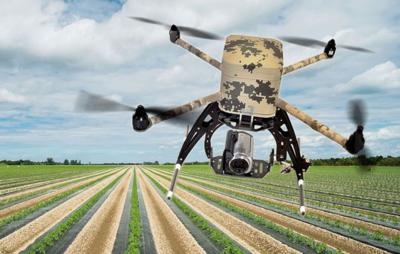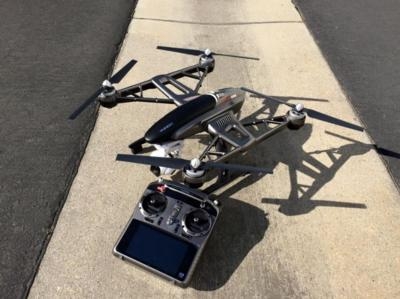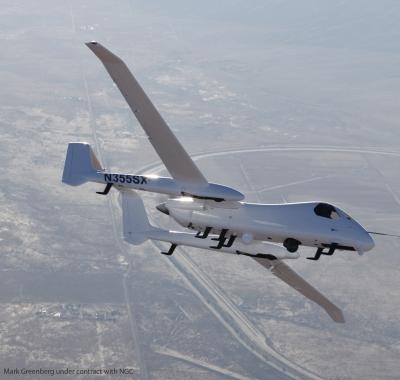Opportunities Exist In Airfreight Delivery, Pipeline Observation, Aerial Photography, Other Sectors
The market for commercial UAVs (drones) shows promise for significant growth because of the more economical visualization and navigation provided by systems, according to research released by Radiant Insights. Visualization includes mapping from the air, inspection from the air, surveillance from the air, and package delivery from the air. The unmanned aircraft equipped with cameras are able to do things that cannot be done in any other way. This bodes well for market development.

The unmanned aerial systems (UAS) markets at $609 million in 2014 are forecast to reach $4.8 billion dollars, worldwide by 2021. This is a sizable market growth with oil and gas mapping, utility line inspection, package delivery, and agricultural applications accounting for virtually all the unit sales, according to the report.
Unmanned aircraft systems promise to achieve a more significant aspect of commercial market presence. Army Unmanned Aircraft Systems flying of 3 million flight hours gives drones market credibility. Eighty eight percent of those hours were logged in combat situations in Iraq and Afghanistan, paving the way for commercial drone markets to develop.
"Police departments, the oil and gas industry, border patrol, and utilities are all using commercial drones," said Susan Eustis, leader of the team that prepared the study. "Units are used for agriculture. Vendors continue to improve the capabilities of these drone aircraft. Their ability to support the commercial endeavors is increasing. Unmanned aircraft have fundamentally changed the accuracy of utility and oil and gas inspections. They are set to fundamentally change how agriculture is conducted."
Japan and Australia have been using drones in agriculture since the 1980s. Worldwide markets are evolving for several compelling applications. High value crops are a target of agricultural robotic development. What could be tastier than a strawberry, perfectly formed, and perfectly ripened? New agricultural robots are able to improve the delivery of consistent quality food, and to implement efficiency in managing food production.
The robotic platforms are capable of site-specific spraying. The capability is targeted spraying only on foliage and selected targets. It can be used for selective harvesting of fruit. The robots detect the fruit, sense its ripeness, then move to grasp and softly detach only ripe fruit.
Drone commercial uses will provide billions of dollars in economic growth. Centers of excellence are evolving worldwide. For the most part, open-use policies are in effect worldwide. Except in the US, Drones are currently mostly banned in the US. The US is more restrictive, it could take months, even years before the FAA offers preliminary guidelines on the commercial use of unmanned aircraft systems
Commercial drones are set to build highways in the sky. The market will only evolve past the early adopter stage after the industry finds ways to build navigation infrastructure that is safe and that works. Roads in the sky will create altitude differences that function as bridges to separate the drones from each other when they are flying at angles to each other.

This type of navigation needs to be defined by industry standards groups, much as the software industry has been able to develop industry stands that provide the base for a market, so also, the commercial drone manufacturers need to come together with representatives from each company and from all the governments to decide on the highways in the sky.
Another aspect of commercial drone markets is the safety issue. If drones become so prevalent that they fall out of the sky on people or homes, this becomes a problem for the people hit or the people who own the homes that are destroyed. As the air crashes from so long ago in the 1920's to yesterday illustrate, people are deterred from commercial drone use by air crashes. Crashes can virtually destroy what is promising to be a burgeoning industry of commercial drones.
The drone industry is going to need to find a way to prevent injuries on the ground before anyone will support the burgeoning industry in any significant way.
In unpopulated areas like to Alaskan oil fields oil pipelines, and utility high wires, there is plenty of space for the drones to make a market. In vast agricultural land areas, drones promise to be able to be used without any danger to humans. The drones create new uses for automated process. The drones are less expensive than manned vehicles and more useful. They are useful in agricultural applications where the cameras are able to do spotting in a manner that is more efficient than the humans can do.

Unmanned aircraft systems are achieving a level of relatively early maturity. Fleets of unmanned aircraft systems have begun to evolve. The U.S. Army has achieved one million flight hours for its unmanned aircraft systems fleet. Unmanned aerial systems have good handling characteristics. UAS units are designed to perform high-speed, long endurance, more covert, multi-mission intelligence, surveillance, and reconnaissance (ISR) and precision-strike missions over land or sea.
Drone units feature a variety of internal loads, including 2,000 lb payload, an Electro-optical/Infrared (EO/IR) sensor, and an all-weather GA-ASI Lynx synthetic aperture radar/ground moving target indicator (SAR/GMTI), maximizing long loiter capabilities.
UAS offers the business persistent situational awareness and mission affordability. For the cost of one manned fighter aircraft, multiple-swarm configured units can cover an area of interest, providing 24/7 ISR coverage, target identification, neutralization, mission flexibility, and attrition tolerance. Some drone UAS have the capability to support manned aircraft missions if desired.
(Images from file)
 ANN's Daily Aero-Linx (04.16.24)
ANN's Daily Aero-Linx (04.16.24) Aero-News: Quote of the Day (04.16.24)
Aero-News: Quote of the Day (04.16.24) Airborne 04.10.24: SnF24!, A50 Heritage Reveal, HeliCycle!, Montaer MC-01
Airborne 04.10.24: SnF24!, A50 Heritage Reveal, HeliCycle!, Montaer MC-01 Airborne 04.12.24: SnF24!, G100UL Is Here, Holy Micro, Plane Tags
Airborne 04.12.24: SnF24!, G100UL Is Here, Holy Micro, Plane Tags Airborne-Flight Training 04.17.24: Feds Need Controllers, Spirit Delay, Redbird
Airborne-Flight Training 04.17.24: Feds Need Controllers, Spirit Delay, Redbird





